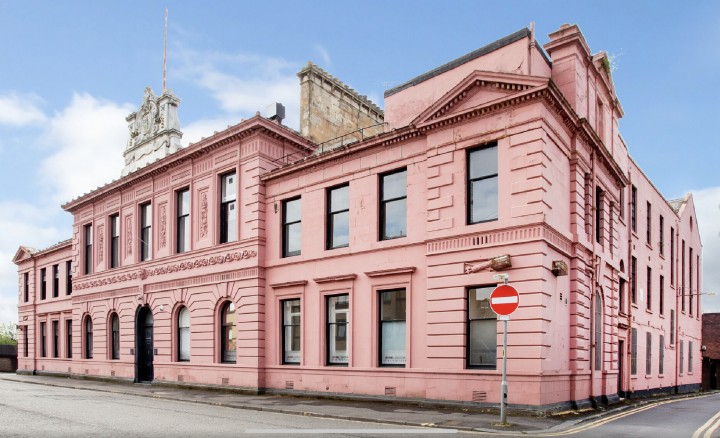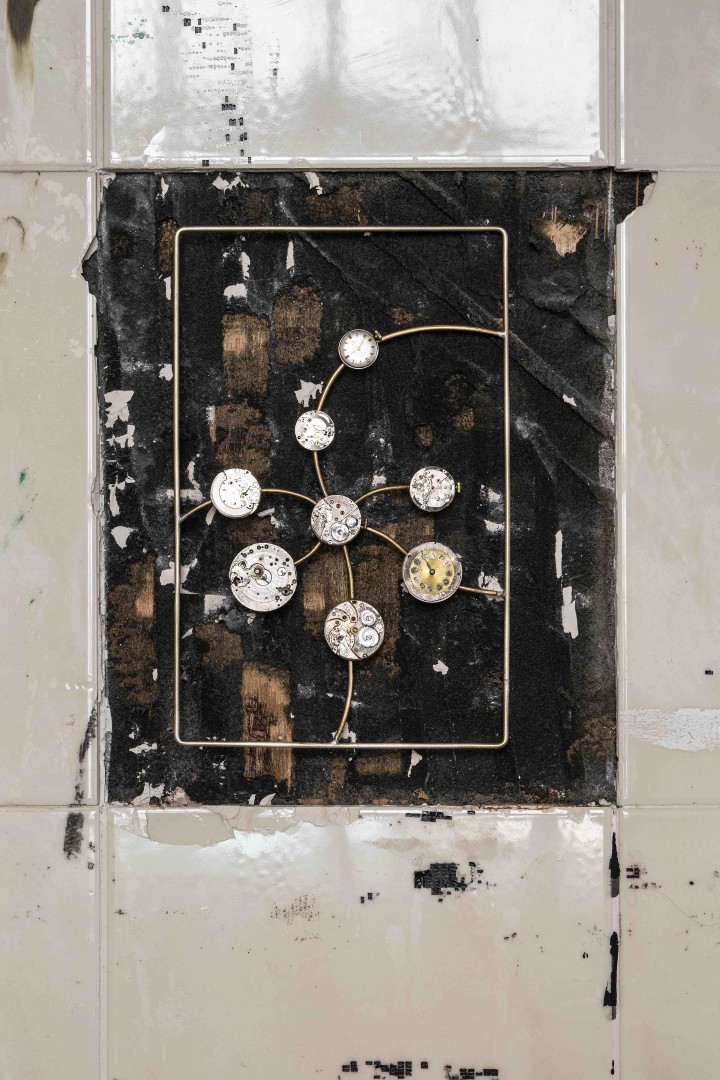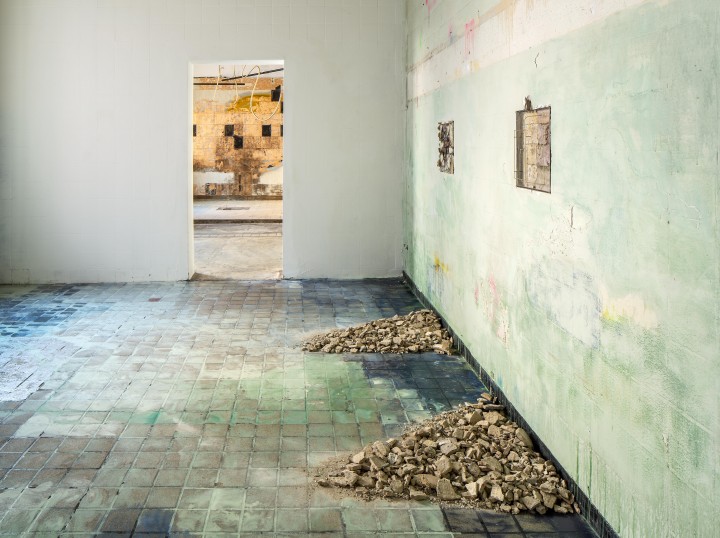Scottish Art News
Latest news
Magazine
News & Press
Publications
Opening of Patricia Fleming Gallery, Glasgow
16.06.2023

During the dark days of the pandemic, gallerist Patricia Fleming made the tough decision to close her Glasgow exhibition space in WASPS, Osborne Street, and devote her time to pop-up projects. Fleming, who represents a impressive list of contemporary artists including Christine Borland, Kate V. Robertson and Ilana Halperin, said she had to make a decision between continuing to pay rent and retaining her staff team.
“In September 2020, the covid regulations were still changing all the time,” she said. “We were open, closed, open, closed. We were open by appointment and cleaning between every visit. It was a clear decision for me to retain the team rather than continuing to pay for a building I couldn’t open.”
 Sara Barker, Watch Movements I, 2023, existing tiles, copper leaf, paint, watch faces, brass, images courtesy of the artist and Patricia Fleming Gallery. Photo: Keith Hunter.
Sara Barker, Watch Movements I, 2023, existing tiles, copper leaf, paint, watch faces, brass, images courtesy of the artist and Patricia Fleming Gallery. Photo: Keith Hunter.
Patricia Fleming Gallery has been operating since 2017, though Fleming herself has a 30-year career as a curator and organiser of art projects in Glasgow. Alongside Modern Institute and Kendall Koppe, her gallery is one of very few commercial galleries for contemporary art in the city, despite Glasgow’s international reputation.
Now, after two years of pop-up projects in Scotland and overseas, Fleming once again has a permanent gallery. For the past six months, she has been working to turn the space at the back of Oxford House, a former Victorian police station south of the Clyde in central Glasgow, into a functioning gallery space. Artist Sara Barker, one of Fleming’s most recent signings, opens the new space with her first solo show in Glasgow since 2017.
She has made new work in response to the space for her show, Watch Movements, making subtle interventions into the tiled walls and creating mobiles and reliefs, in some cases using materials she has taken from the Oxford House rooms.
When I visited, the space was still in the process of being transformed from showers and store rooms into galleries, an archive space and a studio for international residencies. The building closed as a police station in the 1980s and has been largely neglected since, apart from a brief stint as a venue on the underground party scene.
Fleming apologises for the smell of cleaning fluids and paint, saying the project has been “a huge undertaking”. “We don’t do things in a small way, but this gives us elbow room to do what we want to do. We are working with artists to really push their practices forward, and we offer the space and the support to do that.
“Often, we are giving the artist their first exposure to international art fairs. As Sara Barker once said, you can make mistakes in Glasgow, but you can’t get away with not taking risks.”
 17. Sara Barker, Watch Movements, Gallery 2, Installation view, image courtesy of the artist and Patricia Fleming Gallery. Photo: Keith Hunter.
17. Sara Barker, Watch Movements, Gallery 2, Installation view, image courtesy of the artist and Patricia Fleming Gallery. Photo: Keith Hunter.
Fleming first decided to go down the road of opening her own gallery in order to address the dearth of work by women in national collections (she still represents a majority of women artists). “In 2013, I was walking round GoMA with my daughter, and everything we were looking at was by the boys. I thought: where are we? We’re not represented.
“That aspect of the work has been going really well: there’s work by Jackie Donachie in the Tate collection, Sekai Machache in the Scottish Parliament, Ilana Halperin in the National Galleries of Scotland. Every year brings me another notch towards my goal in addressing that balance.”
The other aim is to bring work by contemporary artists (many of them Glasgow-based) to potential collectors at home and overseas. Later this year, Fleming will take the work of Ilana Halperin, Amanda Seibaek and others to international art fairs in New York and Miami, but building a generation of contemporary art collectors at home is also a priority.
“People are still excited by the art scene in Glasgow, it’s still super-vibrant, one of the best places in Europe [to be an artist]. In between the international projects, we are building the local market because we still think that’s important. All the galleries we have met in New York and Miami were able to keep going in the pandemic because they had a really strong collector base. Glasgow has a lot more artists than it has galleries, but collecting sustains galleries and artists.”
Encouraging a home-grown interest in Scottish contemporary art is one reason for the Art Car Boot Sale (ACBS) which takes place at SWG3 on June 24 and 25. Described as Scotland’s biggest contemporary art market, the event is now in its fifth iteration (having missed 2020 and 2021) and will be attended by more than 100 artists selling their work direct from car boots, vans and trestle tables.
It’s a chance to browse prints, editions, maquettes, drawings and, in some cases, original works, and snap up a bargain direct from the artist without gallery premiums. This year’s line-up includes Claire Barclay, Bronwen Sleigh, Toby Paterson, Sam Ainsley, Ross Sinclair and Christine Borland, Roddy Buchanan and Jackie Donachie as well as a host of other mid-career and emerging artists.
 Sara Barker, Paraphernalia, 2023, wall recess, tiles, mortar, paints, silver foil, stainless steel, images courtesy of the artist and Patricia Fleming Gallery. Photo: Keith Hunter.
Sara Barker, Paraphernalia, 2023, wall recess, tiles, mortar, paints, silver foil, stainless steel, images courtesy of the artist and Patricia Fleming Gallery. Photo: Keith Hunter.
Fleming says: “It’s very much a case of ‘Get it while it’s hot’. I had the idea after visiting the studios of Kate V Robertson and David Sherry, and noticing how much stuff they had - and it was beautiful stuff. Clearing the studio helps to make room for new work, and people love talking to the artists direct.
“We don’t make a lot from it, but we don’t mind that because it’s helping to build an appetite for contemporary art in Scotland and an awareness of the artists really shaping the art of now.”
Sara Barker: Watch Movements is exhibited at Patricia Fleming Gallery until 16 July. www.patricia-fleming.com.
The Art Car Boot Sale is at SWG3 on June 24 (10-6) and 25 (11-5), tickets £5 on the door or in advance at https://www.ticketweb.uk/search?q=artcarboot&loc=manhattan-ny




